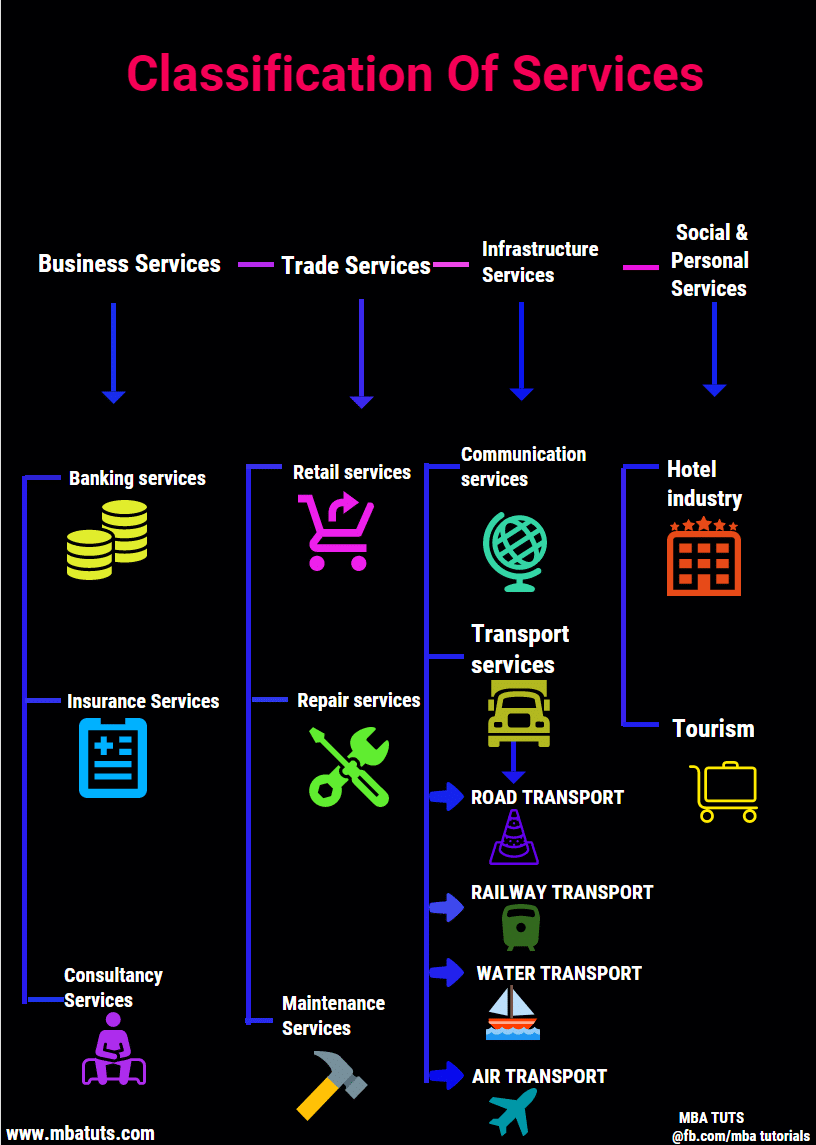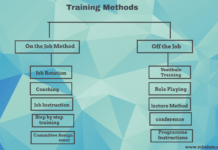Classification of Services
As services are intangible in nature they differ in their process involvement of customers’ involvement of service provider, delivery time, level of customization nature of demand & supply.
Classification is generalized as follows
I. Business Services
They are mainly focused on earning a profit. where there is more involvement of the common public in large numbers. Service involves a lot of economic transaction which is as follows
a) Banking services
The bank is one of the important service providers in the economy it acts as a main regulatory authority. The banking services mainly involve accepting deposits & granting a loan to both common people & industrialists at a stipulated rate of interest. The bank plays a very important role in the circulation of money in the economy.RBI is the authority responsible for credit generation. RBI governor is a major advisor to the finance minister of India. In India there are many nationalized private, cooperative, MNCs banks among these are SBI, ICICI, and HDFC.
b) Insurance Services
Insurance means covering an uncertain risk. The insurance services target the customer by providing life & general insurance with a minimal & reasonable rate of risk. IRDA i.e. Insurance Regulatory Development Authority in India plays a very important role & control. All insurance player in India has a broad objective is to safeguard the interest of the common public.LIC is the pioneer in life insurance to provide security to common people
Because of tuff competition companies like ICICI Prudential, Tata, AIGC, and HDFC Bajaj Alliance are coming up with various insurance plans suitable for different age risk covering, general insurance including fire theft loss, etc.
c) Consultancy Services
In consultancy services, the expert provides certain suggestions or advice to a businessman. industrialist. Nowadays consultancy services are growing at a faster rate. Consultancy service is highly customized & involves both parties
II Trade Services
Trade services are related to tangible products & commodities. These services associate the intangible factors of service with a tangible factor of production. These services are supportive in nature & enhance the tangibility of the product
a) Retail services
b) Repair services
c) Maintenance services
a) Retail services
In retail services, retail outlet acts as a mandatory to sell all tangible product. It adds a shopping area, proper billing, display, home delivery, and telephonic order execution so that buyer gets motivated to buy the product. In India, only 3% of retail services are organized. There are big players like Big Bazaar, Reliance Godrej, etc
b) Repair services
Repair service provides a customer with an after-sale service for e.g Washing machine refrigerator, TV these services are well known for after-sale service
c) Maintenance Services
These are provided to the customer for avoiding malfunctioning or problems in production so as to take care of these products like A.C., and computer labs. The annual contract is created between both parties such a service makes the tangible product more unique & competitive.
III Infrastructure Services
These services are very important in the development of the nation it also stimulates economic & social services.
a) Communication services
In the last 10 years, communication services are in demand these services are provided through land phone mobile, with innovative services. As communication plays a very important role in day to day life of business it has become essential for the common man also.
b) Transport services
We use various services in our daily life. These are carried by rail, road, water or air & made available to the public at their locality. Transport service helps to carry finished products or raw materials from one place to another. Similarly, you must have seen people traveling from one place to another by airplanes, trains, buses, cars, scooters, rickshaws, cycles, etc. This movement of goods and persons is very important in business. This helps the industries to avail of raw materials to the place of manufacturing.
Various modes of transportation are as follows
I) Roadways
Roads are the means that connect one place to another on the surface of the land. You must have seen the roads in your village, in towns and cities. Not all of them look alike. Some of them are made of sand and some may be of chips and cement or coal tar. You find different vehicles plying on roads like bullock carts, cycles, motorcycles, cars, trucks, buses, etc. All of these constitute different means of road transport
ADVANTAGES OF ROAD TRANSPORT.
- It is a relatively cheaper mode of transport as compared to other modes.
- Perishable goods can be transported at a faster speed by road over a short distance.
- Flexible mode of transport as loading and unloading is possible at any destination. It provides door-to-door service.
- Helps people to travel and carry goods from one place to another, particularly in places that are not connected by other means of transport, e.g. hilly areas.
LIMITATIONS OF ROAD TRANSPORT
- It is not economical for long-distance transportation of goods due to their limited carrying capacity.
- Transportation of heavy goods or goods in bulk by road involves high costs.
- It is affected by bad weather conditions like floods, rain, landslide, etc
II Rail Transportation
Indian railways are the 2 largest networks in the world. occupies an important place in our country and is the most dependable mode of transport to carry goods and passengers over a long distance and its total route length is 65000km. Besides long-distance, local transport of passengers is also provided by local trains or metro trains in some metropolitan cities. Rail transport is available throughout the country except for some hilly or mountainous regions.
ADVANTAGES OF RAIL TRANSPORT
(i) It is a convenient mode of transport for traveling long distances.
(ii) It is relatively faster than road transport.
iii) It is suitable for carrying heavy goods in large quantities over long distances.
(iv) Its operation is less affected by adverse weather conditions like rain, floods, fog, etc.
LIMITATIONS OF RAILWAY TRANSPORT
(i) It is relatively expensive for carrying goods and passengers over short distances.
(ii) It is not available in remote parts of the country.
iii) It provides service according to the fixed time schedule and is not flexible for the loading or unloading of goods at any place.
(iv) It involves heavy losses of life as well as goods in case of an accident.
III Water transport
It refers to the movement of goods and passengers on waterways by using various means like boats, steamers, launches, ships, etc. Which helps to carry goods and passengers to different places, both within as well as outside the country. Rivers and canals within the country are used for the movement of boats, ships, etc this is called inland water transport. Where the various means of transport are used to carry goods and passengers on the sea route it is termed ocean transport. Let us know more about these two types of water transport.
INLAND WATER TRANSPORT Inland water transport uses boats, launches, barges, streamers, etc. to carry goods and passengers on the river and canal routes. These routes are called inland waterways and are used in domestic or home trade to carry bulky goods. Passenger transport through waterways is not so popular in our country. The inland water transport system exists only in a few states like West Bengal, Andhra Pradesh, Assam, Tamil Nadu, etc.
OCEAN TRANSPORT Ocean transport refers to the movement of goods and passengers by ships through sea or ocean waterways. It plays an important role in the growth of international trade. It is also used for transporting goods and passengers in coastal areas.
ADVANTAGES OF WATER TRANSPORT
i. It is a relatively economical mode of transport for bulky and heavy goods
ii It is a safe mode of transport with respect to the occurrence of accidents.
iii. The cost of maintaining and constructing routes is very low as most of them are naturally made.
LIMITATIONS OF WATER TRANSPORT
i. The depth and navigability of rivers and canals vary and thus affect the operations of transport vessels of different sizes.
ii. It is a slow-moving mode of transport and therefore not suitable for the transport of perishable goods.
iii. It is adversely affected by weather conditions.
iv.sea transport requires a large investment in ships and their maintenance.
4 AIR TRANSPORT
This is the fastest mode of transport. It carries goods and passengers through airways by using different air crafts like passenger aircraft, cargo aircraft, helicopters, etc. Besides passengers, it generally carries goods that are less bulky or are of high value. In hilly and mountainous areas where another mode of transport is not feasible, air transport is an important as well as convenient mode. During the war, air transport plays an important role in carrying soldiers as well as supplies to the required areas. Air transport may be classified as domestic and international air transport. While domestic air transport mainly facilitates movement within the country, international air transport is used for carrying goods and passengers from different countries. Air transport is carried out in fixed air routes, which connect almost all countries.
ADVANTAGES OF AIR TRANSPORT
1. It is the fastest mode of transport.
2. It is very useful for transporting goods and passengers to areas that are not accessible by any other means of transport.
3. It is the most convenient mode of transport during natural calamities.
4. It provides vital support to national security and defense
LIMITATIONS OF AIR TRANSPORT
- It is a relatively more expensive mode of transport.
- Not suitable for transporting heavy and bulky goods.
- Affected by adverse weather conditions.
- Is not suitable for short-distance travel.
- In case of accidents, it results in heavy losses of goods, property, and life.
4 Social & Personal Services
Due to high disposable income today social & personal services are on the boom today. Everybody wants to spend quality time either on their own or with family so many organizations are in the field of social & personal services
Following are a few Social & Personal Services
- The Hotel industry in India thrives largely due to the growth in tourism and travel. Due to the increase in tourism with rising foreign and domestic tourists, the hotel sector is bound to grow. There is an emergence of budget hotels in India to cater to the majority of the population who seek an affordable stay.
- Hotels: These include business hotels, suite hotels, resort hotels, airport hotels, extended stay hotels, apartment hotels, resort hotels, timeshare hotels, casino hotels, convention centers, and conference centers.
- Tourism has now become a significant industry in India. It is a sunrise industry, an employment generator, and a significant source of foreign exchange for the country. Tourism in India is the third-largest foreign exchange earner in the country.
- As per the World Travel and Tourism Council (WTTC), India is one of the favorite tourist destinations from the year 2009 and will continue to be one of the favorites till 2018. Further, the Travel and Tourism Competitiveness Report by the World Economic Forum has ranked India in sixth place in tourism and hospitality.
- The tourism and hospitality sector is among the top 10 sectors in India to attract the highest Foreign Direct Investment (FDI). According to the data released by the Department of Industrial Policy and Promotion (DIPP), the hotel and tourism sector attracted around US$ 9.2 billion of FDI between April 2000 and March 2016.
For more related articles click here



















